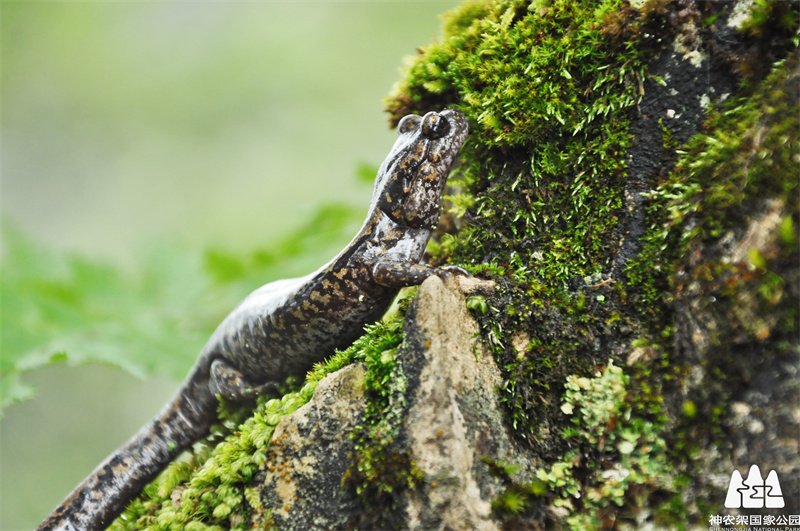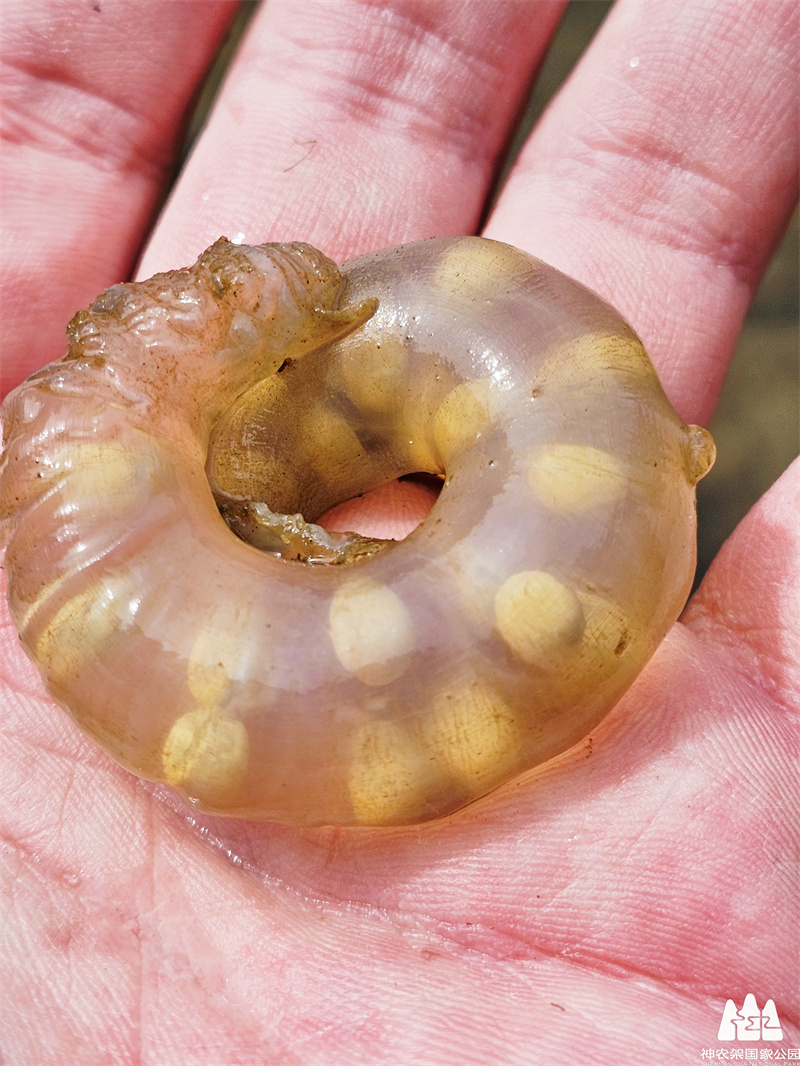A Precious Egg Sac of Wushan Salamanders
Updated:2024-04-02 Source:Shennongjia National Park
In March and April every year, the ice and snow have melted in the Dalongtan area of Shennongjia. After suddenly getting warmer, the weather has turned cold again. The Wushan salamanders (Liua shihi) are hidden deep among the stones. Driven by sexual impulse, they will go to extraordinary lengths to attract members of the opposite sex with their blood boiling, so that they can mate and reproduce. Their privacy is rarely invaded, and their tracks are always hard to detect. However, they will lay their eggs in a place that sunlight can reach under the water. Therefore, this season is also the right time to search for salamanders’ eggs and conduct research on their reproduction.

 Photo by Yu Huiliang
Photo by Yu HuiliangThanks to the good natural resources and environment of Shennongjia, it is not difficult to have a look at the true appearance of the Wushan salamander. They hide themselves under stone seams when they don't move. And they crawl underwater only when they're looking for food and looking for a partner. So it is understandable that most people think it is difficult to find their tracks in the wild, and then come to the conclusion that their number is very small. In fact, in streams and pools flowing water all the year round in the middle and high altitude area of Shennongjia when flipping the water a little bigger and flatter stone, before a few times, you can find one or two of them. Some are 15 to 20 centimeters long adult salamander and some are 3 to 6 centimeters of young salamander.Their feather-like outer gills are exposed in both left and right jaws. They are incomplete metamorphosis animals, also known as larval maturation. This means that they will not, like their amphibians consanguinity frogs, grow up and their tails disappear completely.
To conduct in-depth research on this ancient and rare animal, experts from the Science Research Institute of Shennongjia National Park will not miss this crucial time of the year. Carrying a variety of cutting-edge equipment, they frequent the streams and pools of Shennongjia, carefully searching for traces of these animals and studying their reproduction process.
Yu Huiliang, deputy director of the Institute, has always had a wish to see the Wushan salamanders and their egg sacs with his own eyes. Since March this year, he has often walked among the mountain streams at altitudes above 2,000 meters in expectation of an unexpected discovery. His efforts were rewarded - his wish was granted. On the afternoon of March 16, in a mountain stream in Dalongtan area at an altitude of about 2,240 meters, he stumbled on a round blue object like a coin under the water. Zooming in on the object with a zoom lens, he found that there were about 20 round eggs in the blue object. It was exactly the egg sac of Wushan salamanders. Ecstatic, he realized that this was what he had been wanting for many years. He quickly photographed the egg sac and shared it with his colleagues from the Park.
Dr. Kevin Messenger, an American amphibian and reptile expert from Nanjing Forestry University, has visited Shennongjia more than 10 times since 2006. He usually came in summer and autumn when amphibians and reptiles are more active, so although he has been to Shennongjia many times, he has never seen amphibian eggs. He has always had a wish, that is, to be able to see the Wushan salamander and their egg sac.
Since the beginning of spring this year, Kevin has asked Yu Huiliang, vice president of Shennongjia National Park Science Research Institute, about the temperature and snowmelt conditions in Shennongjia, the stinging conditions and activity of amphibians, and whether they can see salamander eggs on WeChat for many times. More than the president assured him: absolutely can see. On the afternoon of March 16, President Yu found salamander eggs in a mountain stream about 2240 meters above sea level in Dalongtan: the light blue object under the water that is similar to the square hole coin, and sometimes it is nearly a banana-shaped object. In this light blue object, also distributed about 20 beige round eggs. He quickly photographed the egg sac and sent it to Kevin at Nanjing Forestry University. Kevin was overjoyed to see it and hurried to arrange a spring trip to Shennongjia.
 The photo taken by Yu Huiliang on March 16, 2024
The photo taken by Yu Huiliang on March 16, 2024On the 25th of the same month, Kevin came to Shennongjia. In accordance with the guidance of President Yu, he went straight to Dalongtan, and at the same location, he really found the egg sac of the Wushan salamander that he had been longing for. They grew up a lot, and the color of the egg sac was become yellowish, like a transparent rubber bag, and bent into a thick circle. The eggs were evenly arranged in the sac. The mountain stream was cold, only five or six degrees Celsius, but Kevin couldn't resist feeling the texture of the egg sac for himself and getting a closer look at the structure inside. Very carefully he picked up the egg sac from the water, placed it in his hand, which was frozen to red by the cold water, looked at the inside carefully, and then carefully put it back.
 The photo taken by Kevin on March 25, 2024
The photo taken by Kevin on March 25, 2024Our interview team returned to Wuhan because of work, but we still kept the egg sac in mind, worrying that some accidents might happen to it and that the 20 little lives might be harmed. So, we prayed for the salamanders in our hearts, hoping that they would break their shells safely and become the new masters of that mountain stream, and extend the life and legend of the salamanders in that stream. (Written by/Bai Ning and He Sai, Pictured by\Yu Huiliang and Kevin)
Copyright Shennongjia National Park
Address:36 Chulin Road, Muyu Town, Shennongjia Forestry District, Hubei Province 鄂ICP备18005077号-3
Address:36 Chulin Road, Muyu Town, Shennongjia Forestry District, Hubei Province 鄂ICP备18005077号-3
Email:2673990569@qq.com
Phone:0719-3453368
Phone:0719-3453368


TOP

